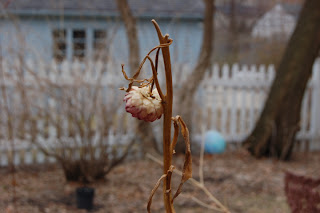 |
That winter-ragged primrose (Primula x acaulis 'Blue') from the last garden post has changed quite a bit, hmm? |
Time marches joyfully onward in the garden. This primrose is the most blatant change in the garden since February 18, but life signs are emerging slowly and steadily.
Tulipa 'Bleu Aimable' is one of my very favorite tulips, because it reproduces so fast. (I have an entire shtick about perennializing tulips that I won't get into right now because it'll take an entire blog post or two on its own to get through. It's good info, though. If you want to know about it now, leave a comment and I'll explain.) For every bulb of 'Bleu Aimable' I plant in fall, every summer I dig up three or four. These are champion bulbs. And beautiful flowers, too - what more could you ask? (In case you haven't noticed, I like tulips.)
A bunch of Tulipa 'Yellow Wave' jumped up without my noticing. These are new - we'll see how they do.
Narcissus 'Barrett Browning' is usually even earlier than the Lent Lilies (Narcissus pseudonarcissus) or Tenby Daffodils (N. obvallaris), just because it's the daffodil in the sunniest, best-drained spot in the garden.
An Aquilegia spp. that was hastily transplanted to this spot late last summer. I can't quite recall where it came from, or exactly what species it is - but we'll find that out when it blooms. It's a rather brave little guy - nights have been dropping into the 20s (ºF) every few days.
Corydalis flexuosa is a name to remember for those of you who love blue Corydalis. I picked up this guy last spring for two reasons (rumors, rather) - rumor one, it does not go dormant during summer, and even manages a summer bloom or two, and rumor two, it is orders of magnitude more hardy than other blue Corydalis. I haven't had it long, but both rumors seem to be at least partially true - early last summer it was briefly drowned in weeds, and lost its foliage, but by searing-hot August it had rallied and regained all of its lost foliage. And now, here we are - March 8, and a Corydalis is showing its head. I like this guy.
Geum triflorum (Prairie Smoke) was new last summer, so I didn't get a chance to see its blooms in the garden, but I've seen Prairie Smoke in dozens of prairies and grasslands throughout the midwest. It's a real beauty, if subtle.
Helleborus x hybridus (or H. orientalis)... possibly a spotted double? I can't recall. Hellebores are another great plant. I know they're expensive, but still - get them. Then divide them. Copiously. (Well, copiously, but not too quickly - maybe once every other year, but even that's pushing it. Let them mature a little, huh?)
Achillea millefolium var. rubra, winter-sowed last winter and transplanted into this spot last fall. Hopefully this year it'll bloom for the first time.
Stachys monnieri 'Hummelo', desperately needing division. This is a great border plant. Wait for it to bloom.
Snowdrops (Galanthus nivalis) begin to rear their heads. It's pretty neat how the flowers come up tucked inside the leaves.
Scilla siberica is a beauty. In Chicago it naturalizes like crazy - whenever I see it in the flowerbeds I move it back in with the pack, just because once you've got one Scilla you've got hundreds, and I hate accidently digging them up and mutilating them when I'm digging and dividing. They're very animal-proof. On a related note, don't eat them.
Crocus species. These are probably my snow crocuses, Crocus chrysanthus 'Blue Pearl', but they might also be one of my various cultivars of Crocus vernus.
Allium schubertii. Now this one doesn't look too impressive, but just wait 'til May or June. Really. Write the name down. Also, though it may appear small, that shoot is about two or three inches long.
Strawflower (Helichrysum bracteatum), a direct-sowed annual that didn't begin to flower 'til at least September last year, and grew much taller than I had planned. I haven't got a place for it this year, so you won't be seeing it again. Say bye-bye.
I haven't cleared away the old foliage and winter mulch, and I won't for a couple weeks yet. We're out of winter proper, but in Chicago we still get light dustings of snow into April, and more rarely into May. The leaf cover protects the tender young foliage of perennials, keeping it pretty and ensuring that the young foliage isn't frozen away by the frosts, freezes and snow. Never get used to bare ground, though - a good cover of vegetable matter is the only reason Chicago's clay keeps from baking solid during summertime.
And no, I haven't forgotten that African Violet post. It's simply suffered some... complications. Yes, complications. You'll see.














No comments:
Post a Comment